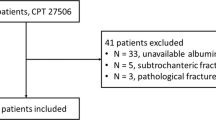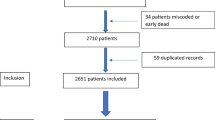Abstract
HYPOTHESIS:
Obesity influences metabolism and increases the incidence of clinical complications and worsens outcomes in pediatric burn patients.
DESIGN:
Retrospective, single-center study.
SUBJECTS:
In all, 592 severely burned pediatric patients who had burns covering more than 30% of the total body surface area and who were treated between 2001 and 2008 were enrolled in this study. Patients were divided into ⩾85th percentile (n=277) and normal (n=315) weight groups based on body mass index (BMI) percentiles.
RESULTS:
Patients stratified below (normal) and ⩾85th percentile had similar age, gender distribution and total burn size. No significant differences were detected in the incidence of sepsis (11% for obese vs 10% for normal), the incidence of multiple organ failure (MOF) (21% for obese and 16% for normal) or mortality (11% for obese vs 8% for normal). Compared with the normal group, the ⩾85th percentile group had low levels of constitutive proteins (α2macroglobulin and Apolipoprotein A1) (P<0.05 for both) as well as high levels of triglycerides and the acute-phase protein, C-reactive protein (P<0.05 for both) up to 60 days after injury. Patients ⩾85th percentile showed a significant higher loss of bone mineral density and lipolysis compared with normal individuals. Stepwise logistic regression analysis revealed that BMI had a positive predictive value towards the maximum DENVER2 score, an index of organ failure (P<0.001).
CONCLUSIONS:
BMI⩾85th percentile altered the post-burn acute phase and catabolic response but did not increase the incidence of sepsis, MOF or mortality in pediatric burn patients. Our results suggest that impaired metabolism and an altered inflammatory response already exists in patients starting at the 85th percentile BMI.
This is a preview of subscription content, access via your institution
Access options
Subscribe to this journal
Receive 12 print issues and online access
$259.00 per year
only $21.58 per issue
Buy this article
- Purchase on Springer Link
- Instant access to full article PDF
Prices may be subject to local taxes which are calculated during checkout





Similar content being viewed by others
References
Oliver T . Post-mortem in a case of extreme obesity. J Anat Physiol 1880; 14 (Part 3): 345–347.
Bochicchio GV, Joshi M, Bochicchio K, Nehman S, Tracy JK, Scalea TM . Impact of obesity in the critically ill trauma patient: a prospective study. J Am Coll Surg 2006; 203: 533–538.
Christmas AB, Reynolds J, Wilson AK, Franklin GA, Miller FB, Richardson JD et al. Morbid obesity impacts mortality in blunt trauma. Am Surg 2007; 73: 1122–1125.
Ciesla DJ, Moore EE, Johnson JL, Burch JM, Cothren CC, Sauaia A . Obesity increases risk of organ failure after severe trauma. J Am Coll Surg 2006; 203: 539–545.
Serrano PE, Khuder SA, Fath JJ . Obesity as a risk factor for nosocomial infections in trauma patients. J Am Coll Surg 2010; 211: 61–67.
Diaz Jr JJ, Norris PR, Collier BR, Berkes MB, Ozdas A, May AK et al. Morbid obesity is not a risk factor for mortality in critically ill trauma patients. J Trauma 2009; 66: 226–231.
Nelson JA, Loredo JS, Acosta JA . The obesity-hypoventilation syndrome and respiratory failure in the acute trauma patient. J Emerg Med 2011; 40: e67–e69.
Sifri ZC, Kim H, Lavery R, Mohr A, Livingston DH . The impact of obesity on the outcome of emergency intubation in trauma patients. J Trauma 2008; 65: 396–400.
Yao-Borengasser A, Varma V, Bodles AM, Rasouli N, Phanavanh B, Lee MJ et al. Retinol binding protein 4 expression in humans: relationship to insulin resistance, inflammation, and response to pioglitazone. J Clin Endocrinol Metab 2007; 92: 2590–2597.
Hotamisligil GS . Inflammatory pathways and insulin action. Int J Obes Relat Metab Disord 2003; 27 (Suppl 3): S53–S55.
Tschop J, Martignoni A, Reid MD, Adediran SG, Gardner J, Noel GJ et al. Differential immunological phenotypes are exhibited after scald and flame burns. Shock 2009; 31: 157–163.
Jeschke MG, Mlcak RP, Finnerty CC, Norbury WB, Gauglitz GG, Kulp GA et al. Burn size determines the inflammatory and hypermetabolic response. Crit Care 2007; 11: R90.
Freedman DS, Sherry B . The validity of BMI as an indicator of body fatness and risk among children. Pediatrics 2009; 124 (Suppl 1): S23–S34.
Mlcak RP, Jeschke MG, Barrow RE, Herndon DN . The influence of age and gender on resting energy expenditure in severely burned children. Ann Surg 2006; 244: 121–130.
Levy MM, Fink MP, Marshall JC, Abraham E, Angus D, Cook D et al. 2001 SCCM/ESICM/ACCP/ATS/SIS International Sepsis Definitions Conference. Crit Care Med 2003; 31: 1250–1256.
Moore FA, Sauaia A, Moore EE, Haenel JB, Burch JM, Lezotte DC . Postinjury multiple organ failure: a bimodal phenomenon. J Trauma 1996; 40: 501–510; discussion 510–2.
Mansell PI, Macdonald IA . Reappraisal of the Weir equation for calculation of metabolic rate. Am J Physiol 1990; 258 (6 Part 2): R1347–R1354.
Finnerty CC, Herndon DN, Chinkes DL, Jeschke MG . Serum cytokine differences in severely burned children with and without sepsis. Shock 2007; 27: 4–9.
Nasraway Jr SA, Albert M, Donnelly AM, Ruthazer R, Shikora SA, Saltzman E . Morbid obesity is an independent determinant of death among surgical critically ill patients. Crit Care Med 2006; 34: 964–970; quiz 971.
Brown CV, Velmahos GC . The consequences of obesity on trauma, emergency surgery, and surgical critical care. World J Emerg Surg 2006; 1: 27.
Nafiu OO, Chimbira WT, Woolford SJ, Tremper KK, Reynolds PI, Green GE . Does high BMI influence hospital charges in children undergoing adenotonsillectomy? Obesity (Silver Spring) 2008; 16: 1667–1671.
Carr DB, Utzschneider KM, Hull RL, Kodama K, Retzlaff BM, Brunzell JD et al. Intra-abdominal fat is a major determinant of the National Cholesterol Education Program Adult Treatment Panel III criteria for the metabolic syndrome. Diabetes 2004; 53: 2087–2094.
Murphey ED, Herndon DN, Sherwood ER . Gamma interferon does not enhance clearance of Pseudomonas aeruginosa but does amplify a proinflammatory response in a murine model of postseptic immunosuppression. Infect Immun 2004; 72: 6892–6901.
Murphey ED, Lin CY, McGuire RW, Toliver-Kinsky T, Herndon DN, Sherwood ER . Diminished bacterial clearance is associated with decreased IL-12 and interferon-gamma production but a sustained proinflammatory response in a murine model of postseptic immunosuppression. Shock 2004; 21: 415–425.
Lazar MA, Plocher EK, Egol KA . Obesity and its relationship with pelvic and lower-extremity orthopedic trauma. Am J Orthop (Belle Mead NJ) 2010; 39: 175–182.
Chang DW, DeSanti L, Demling RH . Anticatabolic and anabolic strategies in critical illness: a review of current treatment modalities. Shock 1998; 10: 155–160.
Jeschke MG, Chinkes DL, Finnerty CC, Kulp G, Suman OE, Norbury WB et al. Pathophysiologic response to severe burn injury. Ann Surg 2008; 248: 387–401.
Williams FN, Jeschke MG, Chinkes DL, Suman OE, Branski LK, Herndon DN . Modulation of the hypermetabolic response to trauma: temperature, nutrition, and drugs. J Am Coll Surg 2009; 208: 489–502.
Ryan CM, Schoenfeld DA, Thorpe WP, Sheridan RL, Cassem EH, Tompkins RG . Objective estimates of the probability of death from burn injuries. N Engl J Med 1998; 338: 362–366.
Pukelsheim K, Stoeger T, Kutschke D, Ganguly K, Wjst M . Cytokine profiles in asthma families depend on age and phenotype. PLoS One 2010; 5: e14299.
Lopez-Garcia E, Schulze MB, Meigs JB, Manson JE, Rifai N, Stampfer MJ et al. Consumption of trans fatty acids is related to plasma biomarkers of inflammation and endothelial dysfunction. J Nutr 2005; 135: 562–566.
Pradhan AD, Manson JE, Rifai N, Buring JE, Ridker PM . C-reactive protein, interleukin 6, and risk of developing type 2 diabetes mellitus. JAMA 2001; 286: 327–334.
Acknowledgements
We thank all the individuals who participated in this clinical trial. We would also like to thank the following research staff for their help and assistance: Deb Benjamin, Wes Benjamin, Joanna Huddleston, Lucy Robles, Sylvia Ojeda, Rosa Chapa, Guadalupe Jecker, Mary Kelly, Karen Henderson, Maria Magno, Liz Montemayor, Victor Baras, Gabriela Kulp and Maricela Pantoja. This work was supported, in part, by the American Surgical Association Foundation, NIH grants R01 GM-08725 (MGJ), R01-GM56687 (DNH), P50-GM60338 (DNH), NIDRR H133A070026 (DNH) and T32-GM08256 (DNH) as well as Shriners Hospitals for Children grants 8740 (CCF), 8660 (MGJ), 9145 and 8760 (DNH). CCF is an ITS Career Development Scholar supported, in part, by NIH KL2RR029875 and NIH UL1RR029876.
Author information
Authors and Affiliations
Corresponding author
Ethics declarations
Competing interests
The authors declare no conflict of interest.
Rights and permissions
About this article
Cite this article
Kraft, R., Herndon, D., Williams, F. et al. The effect of obesity on adverse outcomes and metabolism in pediatric burn patients. Int J Obes 36, 485–490 (2012). https://doi.org/10.1038/ijo.2011.224
Received:
Revised:
Accepted:
Published:
Issue Date:
DOI: https://doi.org/10.1038/ijo.2011.224
Keywords
This article is cited by
-
Association of obesity with morbidity and mortality in critically ill children: a systematic review and meta-analysis of observational studies
International Journal of Obesity (2019)
-
Obesity and the risk and outcome of infection
International Journal of Obesity (2013)



